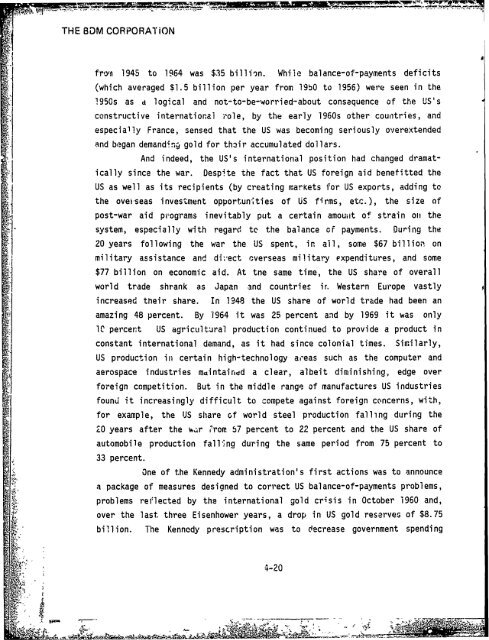policy - The Black Vault
policy - The Black Vault
policy - The Black Vault
Create successful ePaper yourself
Turn your PDF publications into a flip-book with our unique Google optimized e-Paper software.
THE 8DM CORPORATION<br />
fron 1945 to 1964 was $35 billion. While balance-of-payments deficits<br />
(which averaged $1.5 billion per year from 1950 to 1956) were seen in the<br />
1950s as d logical and not-to-be-worried-about consequence of the US's<br />
constructive international r'ole,<br />
by the early 1960s other countries, and<br />
especially France, sensed that the US was becoming seriously overextended<br />
and began demanding gold for th:?ir accumulated dollars.<br />
And indeed, the US's international position had changed dramatically<br />
since the war.<br />
Despite the fact that US foreign aid benefitted the<br />
US as well as its recipients (by creating marKets for US exports, adding to<br />
the ovei-seas investment opportunities of US firms, etc.), the size of<br />
post-war aid programs inevitably put a certain amount of strain oii the<br />
system, especially with regard te the balance of payments. During the<br />
20 years following the war the US spent, in all, some $67 billion on<br />
military assistance and divect overseas military expenditures, and some<br />
$77 billion on economic aid. At tne same time, the US share of overall<br />
world trade shrank as Japan and countries ir. Western Europe vastly<br />
increased their share. In 1948 the US share of world trade had been an<br />
amazing 48 percent. By 1964 it was 25 percent and by 1969 it was only<br />
IC percert US agricultural production continued to provide a product in<br />
constant international demand, as it had since colonial times. Similarly,<br />
US<br />
production in certain high-technology a,-eas such as the computer and<br />
aerospace industries miintairdd a clear, albeit diminishing, edge over<br />
foreign competition. But in the middle range of manufactures US industries<br />
found it<br />
-i 33 percent.<br />
increasingly difficult to compete against foreign concerns, with,<br />
for example, the US share of world steel production falling during the<br />
20 years after the wr prom 57 percent to 22 percent and the US share of<br />
automobile production fall'ing during the same period from 75 percent to<br />
"One of the Kennedy administration's first actions was to announce<br />
a package of measures desioned to correct US balance-of-payments problems,<br />
problems reflected by the international gold crisis in October i960 and,<br />
over the last three Eisenhower years, a drop in US gold reserves of $8.75<br />
billion. <strong>The</strong> Kennedy prescription was to decrease government spending<br />
4-20
















